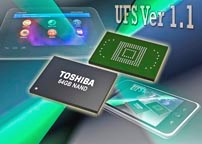For a few years now, e-MMC (Embedded Multi-Media Controller) has been the leading high-density embedded storage solution for mobile devices — and for good reason. As a JEDEC standard solution, widely adopted by an enormous and growing smartphone and tablet market, the e-MCC format enabled a wide variety of applications to take advantage of the infrastructure of memory, chipset, and OS vendors that support this solution. These applications include games, digital video cameras, printers, servers, eReaders, security systems, medical, automotive, and many more. The e-MMC market has skyrocketed from under $1 billion in global sales in 2009 to about $5 billion in 2012, and it continues to grow.
So, what embedded Gbyte storage solution comes after e-MMC? As mobile devices become more sophisticated, interface speeds and system level performance for embedded storage must continue to advance. For this reason, a new JEDEC standard embedded storage interface solution is taking shape — Universal Flash Storage (UFS). Enabling significant boosts in interconnect performance, UFS is intended to be the next generation of mobile mass storage after e-MMC. Like e-MMC, UFS incorporates into one package one or multiple NAND flash die and a controller die that performs NAND management functions such as error code correction (ECC), wear-leveling and block management, to simplify integration into product designs.
UFS operation
UFS is not backward compatible to e-MMC and has a serial interface, in contrast to e-MMC's parallel format. As shown in Fig. 1 , UFS supports full duplexing, enabling both reading and writing between the host processor and UFS device at the same time; e-MMC supports half duplexing, only allowing either reading or writing between the host processor and e-MMC device.

Fig. 1: UFS vs. e-MMC topology.
One key benefit of UFS is its faster interface. While e-MMC version 4.5 and 5.0 have maximum interface speeds of 200 and 400 Mbytes/s, respectively, UFS version 2.0 HS-G2 (High-Speed Gear 2) can support two lanes, each operating at a maximum speed of around 360 Mbytes/s, for a total of 720 Mbytes/s. HS-G3 (High-Speed Gear 3) can support two lanes, each operating at a maximum speed of around 720 Mbytes/s, or 1,440 Mbytes/s total.
Since NAND performance can be a bottleneck, especially for write operations, the benefit of the faster UFS interface is best achieved by interleaving multiple NAND die within the UFS device. This is managed by the UFS controller. For this reason, higher densities, which have more die to interleave, can have higher performance, and are expected to be the target for UFS initially. Figure 2 highlights some key differences between UFS and e-MMC.
Other UFS benefits
The e-MMC solution has a feature called Packed Command, which enables the host system to issue a set of multiple commands to the e-MMC device, rather than one command at a time. However, for e-MMC, these sets of commands must all be read commands, or write commands, but not both intermixed. UFS has Command Queuing, which enables the host system to issue multiple read and write commands, to be executed by the UFS device in parallel, enabling improved system performance.
UFS has better power efficiency during read and write operations, though e-MMC uses less power during idle or sleep states, and therefore e-MMC likely uses less power overall, depending on the application's use case.

Fig. 2: UFS vs. e-MMC: key feature comparison.
Production ramp
The e-MMC market's size and momentum will likely mean that these two mobile embedded solutions will continue to be supported in parallel for some time, with UFS initially supporting the needs of applications demanding higher performance, and typically at higher densities, and e-MMC supporting the needs of applications driven to maintain the lowest cost.

Fig. 3: The THGLF0G9B8JBAIE 64-Gbyte UFS 1.1 storage IC comes in a 169-ball FBGA package.
An earlier version of UFS, version 1.1 (see Fig. 3 ), has been sampling since early 2013 for initial chipset and OS development. UFS version 2.0 is expected to be the first high-speed UFS solution that broadly goes to mass production, in early 2014. UFS will likely take a greater share of the embedded storage market as economies of scale increase and the relative additional cost over that of e-MMC decreases over time.
Advertisement
Learn more about Toshiba America Electronic Components





